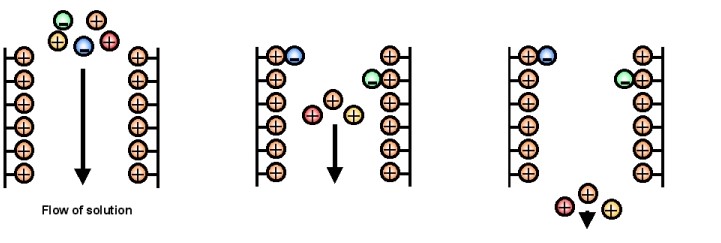Custom Ion-Exchange Chromatography Service
Creative Biostructure provides custom ion-exchange chromatography service for biology macromolecule separation and purification.
Ion-Exchange (IEX) Chromatography is a chromatographic separation method based on the different net surface charge of bio-macromolecules. It is one of the most widely performed techniques for separation and purification of natural/recombinant proteins, peptides, nucleic acids, polysaccharides and other charged bio-macromolecules.
 Figure 1. Basic theory of ion-exchange chromatography.
Figure 1. Basic theory of ion-exchange chromatography.
IEX relies on electrostatic interactions between the function groups of IEX mediums and the target macromolecules. IEX can be categorized into two classes based on the net surface charge of the chromatographic medium: the cation-exchange chromatography and the anion-exchange chromatography. For the cation-exchange chromatography, negatively charged exchanger groups of the mediums capture the positively charged bio-molecules by electrostatic interactions. And for the anion-exchange chromatography, positively charged exchanger groups bind the negatively charged bio-molecules through the same method. All of these electrostatic interactions between the exchangers and target bio-molecules are reversible, so that the captured target bio-molecules can be eluted, usually by elution buffer with high ionic strength. Gradient elution is usually proceeded to optimize the purification.
The net surface charge of a protein changes with the pH. It takes the isoelectric point (pI) of this protein as the criterion. Net surface charge of a protein is zero at the pH equals to its pI. A protein carries positive net surface charge at the pH below its own pI, and it will carry negative net surface charge if the pH is raised above its pI. Researchers must choose the right method to perform protein IEX according to the net surface charge condition of the target protein at the experimental pH.
Creative Biostructure provides various kinds of IEX mediums to meet your different experimental requirements. What's more, both AKTA systems and Bio-Rad systems are available to choose. With many years of experience in bio-macromolecule purification, our science team will establish the optimal IEX strategy for each individual case to meet your requirements.
We also provide other kinds of chromatography and purification services including but not limited to:
Affinity Chromatography
Size-Exclusion Chromatography
Hydrophobic Interaction Chromatography
Reversed Phase Chromatography
TFF/Diafiltration
Please feel free to contact us to discuss your project!
Ordering process
References:
- Sellergren, Börje, and Kenneth J. Shea. "Chiral ion-exchange chromatography: correlation between solute retention and a theoretical ion-exchange model using imprinted polymers." Journal of Chromatography A654.1 (1993): 17-28.
- Knudsen, Heather L., et al. "Membrane ion-exchange chromatography for process-scale antibody purification." Journal of Chromatography A 907.1 (2001): 145-154.
- Williams, Alan, and Verna Frasca. "Ion‐exchange chromatography." Current protocols in protein science (2001): 8-2.

